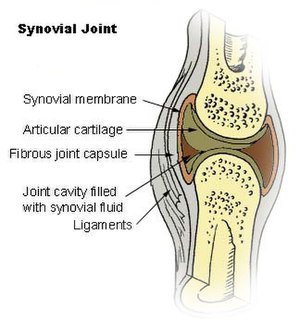| Revision as of 21:26, 6 March 2007 edit65.121.30.30 (talk) →Structure← Previous edit | Revision as of 21:26, 6 March 2007 edit undoSpuriousQ (talk | contribs)Administrators18,090 editsm Reverted 2 edits by 65.121.30.30 (talk) to last version by 81.145.240.149. (vandalism)Next edit → | ||
| Line 7: | Line 7: | ||
| The surfaces of the two bones at the joint are covered in ]. The thickness of the cartilage varies with each joint, and sometimes may be of uneven thickness. Articular cartilage is multi-layered. A thin superficial layer provides a smooth surface for the two bones to slide against each other. Of all the layers, it has the highest concentration of ] and the lowest concentration of ]s, making it very resistant to shear stresses. Deeper than that is an intermediate layer, which is mechanically designed to absorb shocks and distribute the load efficiently. The deepest layer is highly calcified, and anchors the articular cartilage to the bone. | The surfaces of the two bones at the joint are covered in ]. The thickness of the cartilage varies with each joint, and sometimes may be of uneven thickness. Articular cartilage is multi-layered. A thin superficial layer provides a smooth surface for the two bones to slide against each other. Of all the layers, it has the highest concentration of ] and the lowest concentration of ]s, making it very resistant to shear stresses. Deeper than that is an intermediate layer, which is mechanically designed to absorb shocks and distribute the load efficiently. The deepest layer is highly calcified, and anchors the articular cartilage to the bone. | ||
| In joints where the two surfaces do not fit snugly together, a meniscus or multiple folds of ] within the joint correct the fit, ensuring stability and the optimal distribution of load forces. |
In joints where the two surfaces do not fit snugly together, a meniscus or multiple folds of ] within the joint correct the fit, ensuring stability and the optimal distribution of load forces. | ||
| The ] is a membrane that covers all the non-cartilaginous surfaces within the joint capsule. It secretes ] into the joint, which nourishes and lubricates the articular cartilage. The synovium is separated from the capsule by a layer of cellular tissue that contains blood vessels and nerves. | The ] is a membrane that covers all the non-cartilaginous surfaces within the joint capsule. It secretes ] into the joint, which nourishes and lubricates the articular cartilage. The synovium is separated from the capsule by a layer of cellular tissue that contains blood vessels and nerves. | ||
Revision as of 21:26, 6 March 2007

Synovial joints (or diarthroses, or diarthroidal joints) are the most common and most moveable type of joints in the body. As with all other joints in the body, synovial joints achieve movement at the point of contact of the articulating bones. Structural and functional differences distinguish the synovial joints from the two other types of joints in the body, with the main structural difference being the existance of a cavity between the articulating bones and the occupation of a fluid in that cavity which aids movement.
Structure
The whole of a diarthrosis is contained by a ligamentous sac, the joint capsule or articular capsule.
The surfaces of the two bones at the joint are covered in cartilage. The thickness of the cartilage varies with each joint, and sometimes may be of uneven thickness. Articular cartilage is multi-layered. A thin superficial layer provides a smooth surface for the two bones to slide against each other. Of all the layers, it has the highest concentration of collagen and the lowest concentration of proteoglycans, making it very resistant to shear stresses. Deeper than that is an intermediate layer, which is mechanically designed to absorb shocks and distribute the load efficiently. The deepest layer is highly calcified, and anchors the articular cartilage to the bone.
In joints where the two surfaces do not fit snugly together, a meniscus or multiple folds of fibro-cartilage within the joint correct the fit, ensuring stability and the optimal distribution of load forces.
The synovium is a membrane that covers all the non-cartilaginous surfaces within the joint capsule. It secretes synovial fluid into the joint, which nourishes and lubricates the articular cartilage. The synovium is separated from the capsule by a layer of cellular tissue that contains blood vessels and nerves.
Types

1. Ball and socket 2. Condyloid (ellipsoid) 3. Saddle 4. Hinge 5. Pivot
Synovial joints can be further grouped by their shape, which controls the movement they allow. They are divided into six subtypes:
- Ball and socket joints, such as the shoulder and hip joints. These allow a wide range of movement.
- Condyloid joints (or ellipsoidal joints), such as the wrist. A condyloid joint is where two bones fit together with an odd shape (e.g. an ellipse), and one bone is concave, the other convex. Some classifications make a distinction between condyloid and ellipsoid joints.
- Saddle joints, such as at the thumb (between the metacarpal and carpal). Saddle joints, which resemble a saddle, permit the same movements as the condyloid joints.
- Hinge joints, such as the elbow (between the humerus and the ulna). These joints act like a door hinge, allowing flexion and extension in just one plane.
- Pivot joints, such as the elbow (between the radius and the ulna). This is where one bone rotates about another.
- Gliding joints (or planar joints), such as in the carpals of the wrist. These joints allow a wide variety of movement, but not much distance.
| Joints | |
|---|---|
| Types |
|
| Terminology | |
| Motions |
|
| Components | |